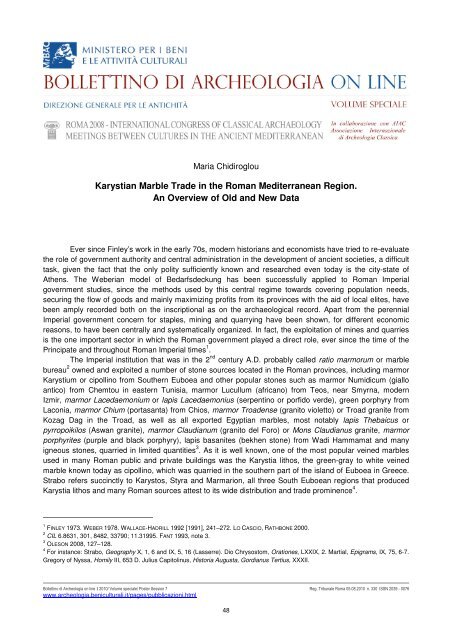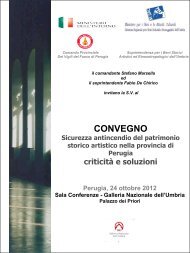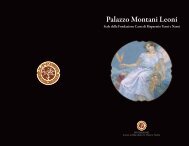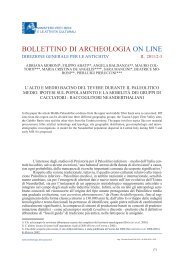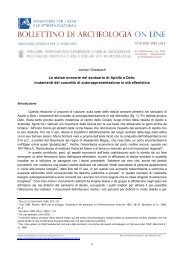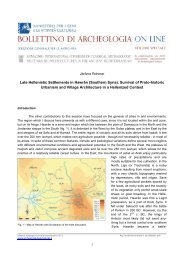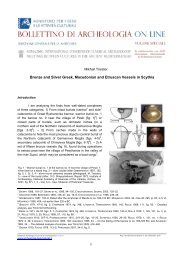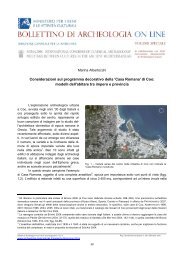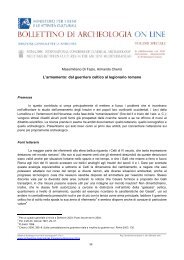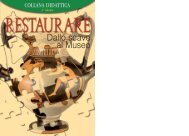Karystian Marble Trade in the Roman Mediterranean Region. An ...
Karystian Marble Trade in the Roman Mediterranean Region. An ...
Karystian Marble Trade in the Roman Mediterranean Region. An ...
You also want an ePaper? Increase the reach of your titles
YUMPU automatically turns print PDFs into web optimized ePapers that Google loves.
Maria Chidiroglou<br />
<strong>Karystian</strong> <strong>Marble</strong> <strong>Trade</strong> <strong>in</strong> <strong>the</strong> <strong>Roman</strong> <strong>Mediterranean</strong> <strong>Region</strong>.<br />
<strong>An</strong> Overview of Old and New Data<br />
Ever s<strong>in</strong>ce F<strong>in</strong>ley’s work <strong>in</strong> <strong>the</strong> early 70s, modern historians and economists have tried to re-evaluate<br />
<strong>the</strong> role of government authority and central adm<strong>in</strong>istration <strong>in</strong> <strong>the</strong> development of ancient societies, a difficult<br />
task, given <strong>the</strong> fact that <strong>the</strong> only polity sufficiently known and researched even today is <strong>the</strong> city-state of<br />
A<strong>the</strong>ns. The Weberian model of Bedarfsdeckung has been successfully applied to <strong>Roman</strong> Imperial<br />
government studies, s<strong>in</strong>ce <strong>the</strong> methods used by this central regime towards cover<strong>in</strong>g population needs,<br />
secur<strong>in</strong>g <strong>the</strong> flow of goods and ma<strong>in</strong>ly maximiz<strong>in</strong>g profits from its prov<strong>in</strong>ces with <strong>the</strong> aid of local elites, have<br />
been amply recorded both on <strong>the</strong> <strong>in</strong>scriptional as on <strong>the</strong> archaeological record. Apart from <strong>the</strong> perennial<br />
Imperial government concern for staples, m<strong>in</strong><strong>in</strong>g and quarry<strong>in</strong>g have been shown, for different economic<br />
reasons, to have been centrally and systematically organized. In fact, <strong>the</strong> exploitation of m<strong>in</strong>es and quarries<br />
is <strong>the</strong> one important sector <strong>in</strong> which <strong>the</strong> <strong>Roman</strong> government played a direct role, ever s<strong>in</strong>ce <strong>the</strong> time of <strong>the</strong><br />
Pr<strong>in</strong>cipate and throughout <strong>Roman</strong> Imperial times 1 .<br />
The Imperial <strong>in</strong>stitution that was <strong>in</strong> <strong>the</strong> 2 nd century A.D. probably called ratio marmorum or marble<br />
bureau 2 owned and exploited a number of stone sources located <strong>in</strong> <strong>the</strong> <strong>Roman</strong> prov<strong>in</strong>ces, <strong>in</strong>clud<strong>in</strong>g marmor<br />
Karystium or cipoll<strong>in</strong>o from Sou<strong>the</strong>rn Euboea and o<strong>the</strong>r popular stones such as marmor Numidicum (giallo<br />
antico) from Chemtou <strong>in</strong> eastern Tunisia, marmor Lucullum (africano) from Teos, near Smyrna, modern<br />
Izmir, marmor Lacedaemonium or lapis Lacedaemonius (serpent<strong>in</strong>o or porfido verde), green porphyry from<br />
Laconia, marmor Chium (portasanta) from Chios, marmor Troadense (granito violetto) or Troad granite from<br />
Kozag Dag <strong>in</strong> <strong>the</strong> Troad, as well as all exported Egyptian marbles, most notably lapis Thebaicus or<br />
pyrropoikilos (Aswan granite), marmor Claudianum (granito del Foro) or Mons Claudianus granite, marmor<br />
porphyrites (purple and black porphyry), lapis basanites (bekhen stone) from Wadi Hammamat and many<br />
igneous stones, quarried <strong>in</strong> limited quantities 3 . As it is well known, one of <strong>the</strong> most popular ve<strong>in</strong>ed marbles<br />
used <strong>in</strong> many <strong>Roman</strong> public and private build<strong>in</strong>gs was <strong>the</strong> Karystia lithos, <strong>the</strong> green-gray to white ve<strong>in</strong>ed<br />
marble known today as cipoll<strong>in</strong>o, which was quarried <strong>in</strong> <strong>the</strong> sou<strong>the</strong>rn part of <strong>the</strong> island of Euboea <strong>in</strong> Greece.<br />
Strabo refers succ<strong>in</strong>ctly to Karystos, Styra and Marmarion, all three South Euboean regions that produced<br />
Karystia lithos and many <strong>Roman</strong> sources attest to its wide distribution and trade prom<strong>in</strong>ence 4 .<br />
1<br />
FINLEY 1973. WEBER 1978. WALLACE-HADRILL 1992 [1991], 241–272. LO CASCIO, RATHBONE 2000.<br />
2<br />
CIL 6.8631, 301, 8482, 33790; 11.31995. FANT 1993, note 3.<br />
3<br />
OLESON 2008, 127–128.<br />
4<br />
For <strong>in</strong>stance: Strabo, Geography Χ, 1, 6 and ΙΧ, 5, 16 (Lasserre). Dio Chrysostom, Orationes, LXXIX, 2. Martial, Epigrams, ΙΧ, 75, 6-7.<br />
Gregory of Nyssa, Homily ΙΙΙ, 653 D. Julius Capitol<strong>in</strong>us, Historia Augusta, Gordianus Tertius, XXXII.<br />
Bollett<strong>in</strong>o di Archeologia on l<strong>in</strong>e I 2010/ Volume speciale/ Poster Session 7 Reg. Tribunale Roma 05.08.2010 n. 330 ISSN 2039 - 0076<br />
www.archeologia.beniculturali.it/pages/pubblicazioni.html<br />
48
Fig. 1 - Karystos, Kyl<strong>in</strong>droi site. Columns<br />
(@ Hellenic M<strong>in</strong>istry of Culture and Tourism/ IA EPKA).<br />
XVII International Congress of Classical Archaeology, Roma 22-26 Sept. 2008<br />
Session: Material Culture and <strong>An</strong>cient Technology / Cultura Materiale e Tecnologia <strong>An</strong>tica<br />
Accord<strong>in</strong>g to numismatic evidence, Karystos, <strong>the</strong> ma<strong>in</strong> polis of <strong>the</strong> sou<strong>the</strong>rn part of Euboea, is first<br />
attested as a city -state <strong>in</strong> <strong>the</strong> sixth century B.C. 5 Dur<strong>in</strong>g most of antiquity, its history and fortune ran parallel<br />
to those of <strong>the</strong> o<strong>the</strong>r Euboean city –states, such as Chalkis and Eretria, with some memorable exceptions,<br />
such as its mediz<strong>in</strong>g role <strong>in</strong> <strong>the</strong> Persian wars of <strong>the</strong> early 5 th century B.C. and its punishment by A<strong>the</strong>nian<br />
military forces <strong>in</strong> <strong>the</strong> second quarter of <strong>the</strong> same century 6 . <strong>Karystian</strong> fortunes certa<strong>in</strong>ly changed <strong>in</strong> <strong>Roman</strong><br />
times and under <strong>Roman</strong> Imperial rule, when systematic and extensive exploitation of <strong>the</strong> region’s quarries is<br />
noted.<br />
In <strong>the</strong> last quarter of <strong>the</strong> 20 th century, systematic surveys conducted by <strong>the</strong> Canadian Archaeological<br />
Institute of A<strong>the</strong>ns and salvage excavations by <strong>the</strong> Archaeological Service of Euboea led to extensive<br />
record<strong>in</strong>g of a great number of sites <strong>in</strong> <strong>the</strong> ancient astu and chora region of Karystos. These <strong>in</strong>clude among<br />
o<strong>the</strong>rs, fortified sites and blockhouses, farm houses, towers, civic and rural sanctuaries, cemeteries, small<br />
quarries, kilns and o<strong>the</strong>r workshop areas and date from prehistoric to late medieval times 7 . The large<br />
complexes of South Euboean marble quarries with <strong>the</strong>ir associated road networks, especially <strong>the</strong> ones on<br />
Mount Ochi to <strong>the</strong> north of Karystos and <strong>the</strong> group of Aghios Nikolaos at Styra, have however been known to<br />
researchers and scholarly travelers ever s<strong>in</strong>ce <strong>the</strong> early 19 th century. The site at Kyl<strong>in</strong>droi to <strong>the</strong> nor<strong>the</strong>ast of<br />
<strong>the</strong> ancient city of Karystos, with its fourteen columns rang<strong>in</strong>g <strong>in</strong> length from 11.20 to 11.90 m. and 0.80 to<br />
1.30 m. <strong>in</strong> diameter had been noticed by J. Hawk<strong>in</strong>s as early as 1820 8 (figs 1, 2).<br />
Horizontal exploitation areas as well as stepped platforms abound <strong>in</strong> <strong>the</strong> quarries of Myloi <strong>in</strong><br />
Karystos, Obores <strong>in</strong> Marmari, Aghios Nikolaos at Styra and Pyrgari at Nimborio. In all three quarry regions<br />
we encounter <strong>the</strong> same types of products, such as columns and pedestals, bases, slabs and build<strong>in</strong>g<br />
material <strong>in</strong> large numbers. It is well known that <strong>the</strong> <strong>Karystian</strong> marble was almost exclusively used for build<strong>in</strong>g<br />
purposes and seldom as sculpture material. Among <strong>the</strong> very few sculptural samples we mention <strong>the</strong><br />
crocodile statue <strong>in</strong> Hadrian’s villa at Tivoli and a palm tree - trunk column <strong>in</strong> <strong>the</strong> courtyard of <strong>the</strong><br />
Archaeological Museum <strong>in</strong> Istanbul 9 . In all three South Euboean quarry regions we f<strong>in</strong>d tool marks, such as<br />
5 th th<br />
See for <strong>in</strong>stance <strong>the</strong> third quarter to end of <strong>the</strong> 6 and early 5 century <strong>Karystian</strong> co<strong>in</strong> types <strong>in</strong>: SELTMAN 1965, 84, pl. XI, 4. KRAAY<br />
1976, 92. Also: Lanz Auktion 111, no. 546.<br />
6<br />
Herodotus, VI, 99.2. VIII, 66.2, 112.2, 121.1. IX, 105. Thucydides, Ι, 98.3. WALLACE 1972, 126–170. CHAPMAN 1993, 17–30. HANSEN,<br />
NIELSEN 2004, 658-659.<br />
7 th<br />
KELLER 1985. Prelim<strong>in</strong>ary reports of surveys: WICKENS 2003-2004. TANKOSIC, CHIDIROGLOU 2006-2007 (Archives of <strong>the</strong> 11 Ephorate<br />
of Prehistoric and Classical <strong>An</strong>tiquities).<br />
8<br />
HAWKINS 1820, 288. RANGABÉ 1852, 34. LOLLING 1989, 420. BAUMEISTER 1864, 28–29. GOUNAROPOULOS 1979[1930], 94–95 (with<br />
mention of quarries at Kagiali Vrachia and Makrona – Kyl<strong>in</strong>droi). PAPAGEORGAKIS 1964, 262–278. HANKEY 1965, 53–59. ZAPPAS 1981-<br />
82, 243–275. LAMBRAKI 1980, 31–62. VANHOVE 1996. SUTHERLAND 2002, 251–259. LAZZARINI, MASI, TUCCI 1995, 161–169. LAZZARINi<br />
2007, 183–198.<br />
9<br />
KLEINER 1992, 247, figs. 212, 213. GNOLI 1971, 154–156, pl. 189. LAZZARINI 2007, 185, figs. 14, 16.<br />
Bollett<strong>in</strong>o di Archeologia on l<strong>in</strong>e I 2010/ Volume speciale/ Poster Session 7 Reg. Tribunale Roma 05.08.2010 n. 330 ISSN 2039 - 0076<br />
www.archeologia.beniculturali.it/pages/pubblicazioni.html<br />
49<br />
Fig. 2 - Karystos, Kyl<strong>in</strong>droi site. <strong>Roman</strong> quarry front<br />
(@ Hellenic M<strong>in</strong>istry of Culture and Tourism/ IA EPKA).
M. Chidiroglou – <strong>Karystian</strong> <strong>Marble</strong> <strong>Trade</strong> <strong>in</strong> <strong>the</strong> <strong>Roman</strong> <strong>Mediterranean</strong> <strong>Region</strong>. <strong>An</strong> Overview of Old and New Data<br />
Fig. 3 - Karystos, Myloi. Block with po<strong>in</strong>tillé traces<br />
(@ Hellenic M<strong>in</strong>istry of Culture and Tourism/ IA EPKA).<br />
Fig. 5 - Mount Ochi, Dragon House. South side, with entrance<br />
(@ Hellenic M<strong>in</strong>istry of Culture and Tourism/ IA EPKA).<br />
Bollett<strong>in</strong>o di Archeologia on l<strong>in</strong>e I 2010/ Volume speciale/ Poster Session 7 Reg. Tribunale Roma 05.08.2010 n. 330 ISSN 2039 - 0076<br />
www.archeologia.beniculturali.it/pages/pubblicazioni.html<br />
50<br />
Fig. 4 - Platanistos, Helleniko site. South side of ancient reta<strong>in</strong><strong>in</strong>g<br />
terrace (@ Hellenic M<strong>in</strong>istry of Culture and Tourism/ IA EPKA).<br />
of <strong>the</strong> po<strong>in</strong>tillé and wedge technique, a number of<br />
metallurgical bas<strong>in</strong>s, as well as reta<strong>in</strong><strong>in</strong>g walls and<br />
quarry road networks or lithagogiai. Some of <strong>the</strong><br />
tool marks at <strong>the</strong> multiple quarries at Myloi, especially<br />
those of <strong>the</strong> po<strong>in</strong>tillé type can be dated to <strong>the</strong><br />
5 th and 4 th centuries B.C., if not earlier (fig. 3).<br />
The monumental reta<strong>in</strong><strong>in</strong>g walls of a temple<br />
dedicated most probably to A<strong>the</strong>na at Helleniko<br />
Platanistos, a site of <strong>the</strong> eastern <strong>Karystian</strong><br />
chora, were built with <strong>Karystian</strong> schist stone and<br />
Parian marble. On <strong>the</strong> base of two <strong>in</strong>scriptions preserved<br />
<strong>in</strong> situ, <strong>the</strong> temple can be dated <strong>in</strong> <strong>the</strong> late<br />
6 th to early 5 th century B.C. 10 (fig. 4). Great slabs of<br />
<strong>Karystian</strong> schist stone and marble have been used<br />
<strong>in</strong> <strong>the</strong> so-called Dragon House of Mount Ochi. This<br />
monumental build<strong>in</strong>g also of <strong>the</strong> <strong>Karystian</strong> chora<br />
has been dated between <strong>the</strong> 5 th century B.C and<br />
2 nd century A.D. Its architectural details, such as<br />
<strong>the</strong> decorative sculpted edges of some of its slabs, conform to a late 5 th to 4 th century date (fig. 5). Ceramic<br />
f<strong>in</strong>ds and graffiti attest to an early 5 th century use of <strong>the</strong> space, for religious purposes, as many of <strong>the</strong> 19 th<br />
century scholars had already surmised 11 . Apart from <strong>the</strong>se monumental build<strong>in</strong>gs of <strong>the</strong> <strong>Karystian</strong> city – state<br />
chora region, some cipoll<strong>in</strong>o and ma<strong>in</strong>ly schist slabs are found to have been used <strong>in</strong> <strong>in</strong>stallations, such as<br />
towers, farm houses and sanctuaries surveyed or excavated <strong>in</strong> <strong>the</strong> <strong>Karystian</strong> astu sites, as well as <strong>in</strong><br />
fortifications and towers <strong>in</strong> <strong>the</strong> region of <strong>the</strong> ancient demos of Styra 12 . We can safely claim that, although<br />
grand scale exploitation of <strong>the</strong> <strong>Karystian</strong> quarries is attested dur<strong>in</strong>g <strong>Roman</strong> times, a previous, smaller scale,<br />
local exploitation of some quarries, mostly <strong>the</strong> ones of schist limestone, which is similar and close to <strong>the</strong><br />
10 BURSIAN 1856, 38. BURSIAN 1868-1872, 435. BAUMEISTER 1864, 34. LOLLING 1989, 429–430. YOUNG 1930, 20–23. GOETTE 2000,<br />
399–403. PAPAVASSILEIOU 1908, 101–113. SAPOUNA, SAKELLARAKI, ArchDelt 49 (1999), 298–299. GOETTE 2007, 283–291.<br />
11 HAWKINS 1820, 285–293. RANGABE 1852, 34. GIRARD 1851, 708–730 = GIRARD 1852, 74–91 = LACROIX 1853, 411–412. LOLLING<br />
1989, 421–426. BAUMEISTER 1864, 29–30. SACKETT ET ALII 1966, 81, no. 91. MOUTSOPOULOS 1982, 281–325.<br />
12 Constructions of Classical and Hellenistic times, built of local schist and marble stone: KELLER 1985, 87, 90, 131, 132, 142–144, 146,<br />
156–157. CHATZIDIMITRIOU 2006, 82–89.
Fig. 6 - Cipoll<strong>in</strong>o distribution map (Maria Chidiroglou 2010, <strong>in</strong> preparation).<br />
XVII International Congress of Classical Archaeology, Roma 22-26 Sept. 2008<br />
Session: Material Culture and <strong>An</strong>cient Technology / Cultura Materiale e Tecnologia <strong>An</strong>tica<br />
marble ve<strong>in</strong>s 13 , by <strong>the</strong> city –state of Karystos, given <strong>the</strong> easy quarry<strong>in</strong>g and great construction potential of all<br />
local stones, should not cause surprise. In <strong>the</strong> area of Aetos, to <strong>the</strong> east of Karystos, for <strong>in</strong>stance, both a<br />
limestone quarry and cipoll<strong>in</strong>o members have been located 14 . Accord<strong>in</strong>g to <strong>in</strong>scriptional testimony, <strong>the</strong><br />
ancient demos of Styra, to <strong>the</strong> northwest of <strong>the</strong> <strong>Karystian</strong> region, became part of <strong>the</strong> Eretrian city-state <strong>in</strong> <strong>the</strong><br />
late 5 th century B.C. 15 . In this expanded Eretrian chora region, <strong>the</strong>re are also many <strong>in</strong>dications of a local use<br />
of Styrian limestone and marble, before <strong>Roman</strong> times 16 .<br />
Great and systematic exploitation of South Euboean quarry complexes is first noticed <strong>in</strong> <strong>Roman</strong><br />
Imperial and <strong>the</strong>n <strong>in</strong> Byzant<strong>in</strong>e times. Inscriptions testify that <strong>the</strong> <strong>Karystian</strong> quarries and <strong>the</strong>ir products were<br />
owned by <strong>the</strong> Emperor, who used a network of delegates and adm<strong>in</strong>istration officials, freedmen <strong>in</strong>cluded, to<br />
control and profit from this grand scale enterprise 17 . Two published <strong>in</strong>scriptions and a newly found one at<br />
Castel Rosso, <strong>the</strong> Medieval Castle of Karystos, attest to <strong>the</strong> high status an Augustan freedman, such as<br />
Hymenaios Thamyrianos, could acquire as quarry adm<strong>in</strong>istration official <strong>in</strong> Karystos, <strong>in</strong> <strong>the</strong> early 1 st century<br />
13<br />
The <strong>Karystian</strong> cipoll<strong>in</strong>o marble is geologically described as deriv<strong>in</strong>g from marly limestones by low - grade metamorphism: LAZZARINI,<br />
MASI, TUCCI 1995, 161.<br />
14<br />
KELLER 1985, 150–151.<br />
15<br />
IG II², 230 b. IG XII, 162. KNOEPFLER 1971, 223–244.<br />
16<br />
Late Classical to Hellenistic square towers at Styra, known as Dragon Houses, such as <strong>the</strong> build<strong>in</strong>gs preserved at Viglia - Lefka,<br />
Limiko - Kapsala and Ilkizes near Porto Lafia are constructed of hard, schist limestone blocks with some cipoll<strong>in</strong>o <strong>in</strong>cluded.<br />
MOUTSOPOULOS 1982. REBER 2001, 339–351.<br />
17<br />
CIL III, Suppl. II, 12286. <strong>Karystian</strong> petition to Hadrian for <strong>the</strong> open<strong>in</strong>g of new quarries: ILS 8717 = Bruzza, no. 1. BLAKE 1947, 58, n.<br />
38. DODGE, WARD-PERKINS 1992, 26–28.<br />
Bollett<strong>in</strong>o di Archeologia on l<strong>in</strong>e I 2010/ Volume speciale/ Poster Session 7 Reg. Tribunale Roma 05.08.2010 n. 330 ISSN 2039 - 0076<br />
www.archeologia.beniculturali.it/pages/pubblicazioni.html<br />
51
M. Chidiroglou – <strong>Karystian</strong> <strong>Marble</strong> <strong>Trade</strong> <strong>in</strong> <strong>the</strong> <strong>Roman</strong> <strong>Mediterranean</strong> <strong>Region</strong>. <strong>An</strong> Overview of Old and New Data<br />
Fig. 7 - Rome. <strong>Roman</strong> Forum. Temple of <strong>An</strong>ton<strong>in</strong>us Pius and Faust<strong>in</strong>a. 138-161<br />
A.D. (Su concessione del M<strong>in</strong>istero peri i Beni e le Attività Culturali -<br />
Sopr<strong>in</strong>tendenza Speciale per i Beni Archeologici di Roma.)<br />
Fig. 8 - A<strong>the</strong>ns. Hadrian’s Library. 117-138 A.D. Western build<strong>in</strong>g side. Cipoll<strong>in</strong>o<br />
columns (@ Hellenic M<strong>in</strong>istry of Culture and Tourism/ A EPKA.).<br />
Bollett<strong>in</strong>o di Archeologia on l<strong>in</strong>e I 2010/ Volume speciale/ Poster Session 7 Reg. Tribunale Roma 05.08.2010 n. 330 ISSN 2039 - 0076<br />
www.archeologia.beniculturali.it/pages/pubblicazioni.html<br />
52<br />
A.D. 18 . Among o<strong>the</strong>r officials of<br />
Greek descent was A. Plōtios Leōnidēs,<br />
<strong>the</strong> <strong>in</strong>scribed cipoll<strong>in</strong>o base of<br />
whose statue stands <strong>in</strong> Karystos Museum<br />
today and dates <strong>in</strong> <strong>the</strong> 1 st century<br />
A.D. and L. Marcius Ner[o,<br />
whose bil<strong>in</strong>gual funerary stele is reported<br />
to have been found <strong>in</strong> <strong>the</strong> port<br />
of Karystos 19 . Pentelic marble <strong>in</strong><br />
comb<strong>in</strong>ation with good quality cipoll<strong>in</strong>o,<br />
have been used <strong>in</strong> <strong>the</strong> construction<br />
of a mausoleum built for a <strong>Roman</strong><br />
official, near <strong>the</strong> port <strong>in</strong> <strong>the</strong> modern<br />
city of Karystos, <strong>in</strong> <strong>An</strong>ton<strong>in</strong>e times,<br />
<strong>in</strong> order to emphasize <strong>the</strong> high<br />
status of this <strong>in</strong>dividual 20 . <strong>An</strong> officer<br />
named Claudianus is attested <strong>in</strong> <strong>the</strong><br />
Pyrgari and Aghios Nikolaos quarries.<br />
Two cipoll<strong>in</strong>o columns found <strong>in</strong><br />
2003 <strong>in</strong> a small stock pile <strong>in</strong> <strong>the</strong><br />
sandy beach of Nimborio to <strong>the</strong> south<br />
of Styra, bear trade marks with <strong>the</strong><br />
same name, <strong>in</strong>dicat<strong>in</strong>g <strong>the</strong> wide range<br />
of activities undertaken by <strong>Roman</strong><br />
quarry supervisors 21 . Sergius Longus,<br />
a centurion, dedicated a niche to<br />
Hercules, near <strong>the</strong> Kyl<strong>in</strong>droi site, <strong>in</strong><br />
<strong>the</strong> first half of <strong>the</strong> 2 nd century A.D.,<br />
as <strong>the</strong> Lat<strong>in</strong> <strong>in</strong>scription at its base<br />
testifies. The same man is known<br />
from an <strong>in</strong>scription <strong>in</strong> Rome 22 .<br />
The <strong>Karystian</strong> marble traveled<br />
extensively to Greece, Italy, Cyprus,<br />
Egypt and North Africa, Syria,<br />
Judaea, <strong>the</strong> region of modern Dalmatia,<br />
France, Brita<strong>in</strong> and Spa<strong>in</strong> (fig.<br />
6). Accord<strong>in</strong>g to <strong>the</strong> extant monuments<br />
where cipoll<strong>in</strong>o was primarily<br />
used, its trade peaked <strong>in</strong> Augustan,<br />
Hadrianic and <strong>An</strong>ton<strong>in</strong>e times. Its first<br />
columnar use <strong>in</strong> a <strong>Roman</strong> environment is considered to have been <strong>in</strong> Mamourra’s house <strong>in</strong> <strong>the</strong> 1 st century<br />
B.C. 23 Exploitation, distribution and re-use of quarried members cont<strong>in</strong>ued dur<strong>in</strong>g Byzant<strong>in</strong>e times and <strong>in</strong><br />
some cases reached modern times. A large number of cipoll<strong>in</strong>o columns were used <strong>in</strong> <strong>Roman</strong> temples, Fora,<br />
18<br />
CIL III, 563, 987, no. 12289. FRANK 1938, 464–465 (: probator or arcarius).<br />
19<br />
IG XII.9.24 (Karystos Museum <strong>in</strong>v. no. 116). IG XII.9.32. CIL III, 12287. WALLACE 1972, 293, 300, 326–327.<br />
20<br />
PAPAVASSILEIOU 1908, 101–113. GOETTE 1994, 259–300.<br />
21<br />
Claudianus <strong>in</strong>scription at Styra: MOUTSOPOULOS 1982, 338, fig. 51. VANHOVE 1989, 226–230. VANHOVE 1996, 16. Claudianus<br />
<strong>in</strong>scription at Nimborio, now stored <strong>in</strong> <strong>the</strong> court of Karystos Archaeological Museum: CHIDIROGLOU 2009, 76, figs. 5-7.<br />
22<br />
CIL III, Suppl. II, 12286. IG XII.9, 154–155. CHAPMAN 1993, 69.<br />
23 Pl<strong>in</strong>y <strong>the</strong> Elder, Natural History, XXXVI, 7.
XVII International Congress of Classical Archaeology, Roma 22-26 Sept. 2008<br />
Session: Material Culture and <strong>An</strong>cient Technology / Cultura Materiale e Tecnologia <strong>An</strong>tica<br />
bath complexes and colonnaded streets lead<strong>in</strong>g to city centers, such as for <strong>in</strong>stance <strong>in</strong> Rome 24 , Ostia,<br />
Cor<strong>in</strong>th, Cyrene and Leptis Magna. Well known <strong>in</strong>stances of cipoll<strong>in</strong>o columns used <strong>in</strong> <strong>the</strong> construction of<br />
<strong>Roman</strong> monuments are <strong>the</strong> propylon of Hadrian’s Library <strong>in</strong> A<strong>the</strong>ns and <strong>the</strong> preserved colonnade of <strong>the</strong><br />
temple of <strong>An</strong>ton<strong>in</strong>us Pius and Faust<strong>in</strong>a <strong>in</strong> Rome (figs. 7, 8). <strong>Karystian</strong> marble slabs were used as opus<br />
sectile <strong>in</strong> floors of monumental build<strong>in</strong>gs, such as <strong>the</strong> Octagonon <strong>in</strong> Thessalonike and Agrippa’s Odeion <strong>in</strong><br />
<strong>the</strong> A<strong>the</strong>nian Agora 25 . A prelim<strong>in</strong>ary <strong>in</strong>vestigation on <strong>the</strong> cipoll<strong>in</strong>o distribution locations leads to several<br />
<strong>in</strong>terest<strong>in</strong>g remarks, such as <strong>the</strong> emphasis given to set sizes of monolithic columns, pedestals and piers<br />
throughout all <strong>Roman</strong> exploitation period, <strong>the</strong> re-use of cipoll<strong>in</strong>o architectural members <strong>in</strong> medieval<br />
monuments and <strong>the</strong> symbolic connotations of cipoll<strong>in</strong>o colours throughout its history <strong>in</strong> <strong>Roman</strong>, Christian and<br />
Muslim build<strong>in</strong>gs.<br />
We conclude that, <strong>the</strong> systematic and <strong>in</strong>tensive <strong>Roman</strong> exploitation did not preclude a smaller scale,<br />
earlier use of some quarries <strong>in</strong> Myloi, Aetos and Styra by <strong>the</strong> city states of Karystos and Eretria<br />
correspond<strong>in</strong>gly. The use of green limestone and cipoll<strong>in</strong>o marble <strong>in</strong> monuments of <strong>the</strong> 5 th to 4 th century B.C.<br />
<strong>in</strong> <strong>the</strong> ancient cities of Karystos and Eretria 26 , as well as tool marks and some of <strong>the</strong> known quarry<br />
<strong>in</strong>scriptions 27 , <strong>in</strong>dicate a sporadic Classical to Hellenistic local use of this bountiful South Euboean economic<br />
resource, <strong>in</strong> order to cover <strong>the</strong> religious, public and private build<strong>in</strong>g needs of <strong>the</strong> region, with little or nonexistent<br />
trade orientation. Based on <strong>the</strong> f<strong>in</strong>ds of survey and salvage excavations <strong>in</strong> Karystia, we can claim<br />
that <strong>the</strong> limited local exploitation of <strong>the</strong> limestone and marble sources seems to have concentrated on<br />
build<strong>in</strong>g blocks and sarcophagi dur<strong>in</strong>g <strong>the</strong> Classical and Hellenistic periods. The overall picture changed <strong>in</strong><br />
quantitative measure and market orientation <strong>in</strong> <strong>Roman</strong> times, s<strong>in</strong>ce a centrally organized adm<strong>in</strong>istration,<br />
such as <strong>the</strong> Emperor and his regional delegates, were responsible for all marble quarry<strong>in</strong>g and trade stages,<br />
from supervis<strong>in</strong>g <strong>the</strong> great numbers of workers <strong>in</strong> various quarry complexes, to systematiz<strong>in</strong>g <strong>the</strong> type, size<br />
and stock pil<strong>in</strong>g of products and organiz<strong>in</strong>g a network of near trade stations and distant dest<strong>in</strong>ations, based<br />
on well known <strong>Mediterranean</strong> sea routes and <strong>the</strong> co-ord<strong>in</strong>ation of local agents, rewarded by riches and<br />
honors at <strong>the</strong> local elite competition arena or even <strong>in</strong> Rome itself. Diocletian’s Edict, a slab of which had<br />
been found <strong>in</strong> Karystos, attests to <strong>the</strong> cont<strong>in</strong>ued trade importance of <strong>the</strong> stone <strong>in</strong> late <strong>Roman</strong> times 28 .<br />
Maria Chidiroglou<br />
Ph.D. candidate at <strong>the</strong> University of A<strong>the</strong>ns.<br />
Hellenic M<strong>in</strong>istry of Culture department of Archaeological Sites, Monuments and Research<br />
(formerly <strong>in</strong> <strong>the</strong> 11 th Ephorate of Prehistoric and Classical <strong>An</strong>tiquities, Euboea, Greece).<br />
24 CORSI 1845. MAISCHBERGER 1997, 138, 142–147, 157, 164, 168.<br />
25 DODGE 1988, 215–230. ROMANELLI 1925. PENSABENE–LAZZARINI 2007, 306. BIERS 1985, 8, 11, 18, 26, 39, 50, 66, pls 12, 46, 47.<br />
HARRISON 1965, 139, 171, nos. 223, 224. THOMPSON 1950, 31–141. LAZZARINI 2007, 187, fig. 18. For Hadrian’s Library <strong>in</strong> A<strong>the</strong>ns, see<br />
for <strong>in</strong>stance: WARD-PERKINS 1970, 269–271. TRAVLOS 1971, 244–252. MARTINI 1985, 189–191. TRAVLOS 1986-1989, 343–347. SHEAR<br />
JR. 1981, 356–377. WILLERS 1990, 14–21. CHOREMI-SPETSIERI 1995, 137–147. GOETTE 2001 [1993], 90–91.<br />
26 Cipoll<strong>in</strong>o slabs and blocks <strong>in</strong> late Classical to Hellenistic build<strong>in</strong>g rema<strong>in</strong>s, sarcophagi and <strong>in</strong>scriptions <strong>in</strong> Karystos: CHATZIDIMITRIOU<br />
2006, 82–89 (4th century B.C. tower built of limestone and cipoll<strong>in</strong>o blocks). CHIDIROGLOU 2006, 104–118 (report on <strong>the</strong> ancient<br />
necropolis excavations). IG XII.9.13 & 23 (late Classical <strong>in</strong>scriptions on Karystia lithos slabs). Cipoll<strong>in</strong>o <strong>in</strong> Styra, <strong>in</strong> Eretrian territory:<br />
Moutsopoulos 1982 (construction details of <strong>the</strong> Dragon Houses <strong>in</strong> Styra), esp. 403–404.<br />
27 LAMBRAKI 1981: Diokles and o<strong>the</strong>r <strong>in</strong>scriptions <strong>in</strong> Greek letters. A Classical horos <strong>in</strong>scription of <strong>the</strong> Dē[mos] of Styra is however<br />
located on a slope to <strong>the</strong> south and at some distance from <strong>the</strong> quarry group at Aghios Nikolaos: MOUTSOPOULOS 1982, 338–342, figs.<br />
54, 55.<br />
28 Diocletian’s Edict stele from Karystos <strong>in</strong> <strong>the</strong> Epigraphical Museum <strong>in</strong> A<strong>the</strong>ns (<strong>in</strong>v. no. ΕΜ 10067): LAUFFER 1971, 7–9, 26–27.<br />
Bollett<strong>in</strong>o di Archeologia on l<strong>in</strong>e I 2010/ Volume speciale/ Poster Session 7 Reg. Tribunale Roma 05.08.2010 n. 330 ISSN 2039 - 0076<br />
www.archeologia.beniculturali.it/pages/pubblicazioni.html<br />
53
M. Chidiroglou – <strong>Karystian</strong> <strong>Marble</strong> <strong>Trade</strong> <strong>in</strong> <strong>the</strong> <strong>Roman</strong> <strong>Mediterranean</strong> <strong>Region</strong>. <strong>An</strong> Overview of Old and New Data<br />
Abbreviations<br />
IG XII.9. Ziebarth E1915. Inscriptiones Graecae, XII.9. Berl<strong>in</strong>.<br />
IG II² Kirchner J. 1913 -1940. Inscriptiones Atticae Euclidis anno posteriores II². Berl<strong>in</strong>.<br />
Bibliography<br />
BAUMEISTER A., 1864. Topographische Skizze der Insel Euboia. Lübeck.<br />
BIERS J. C., 1985. Cor<strong>in</strong>th XVII, The Great Bath on <strong>the</strong> Lechaion Road. Pr<strong>in</strong>ceton New Jersey.<br />
BLAKE M. E., 1947. <strong>An</strong>cient <strong>Roman</strong> Construction <strong>in</strong> Italy from <strong>the</strong> Prehistoric Period to Augustus.<br />
Wash<strong>in</strong>gton.<br />
BRUNO M., 1998. Su un fusto colossale di cipoll<strong>in</strong>o sopra le cave di Kyl<strong>in</strong>droi nel distretto di Myloi. Studi<br />
Miscellanei, 31, 327–330.<br />
BRUZZA L., 1870. Iscrizioni dei marmi grezzi. <strong>An</strong>nali dell’ Instituto di Corrispondenza Archeologica.<br />
BURSIAN C., 1868-1872. Geographie von Griechenland, II, Peloponnesos und Inseln. Leipzig, 428–438.<br />
BURSIAN C., 1856. Questionum Euboicarum Capita Selecta. Lipsiae.<br />
CASCIO, LO E., RATHBONE D. W. (eds), 2000. Production and Public Powers <strong>in</strong> Classical <strong>An</strong>tiquity. The<br />
Cambridge Philological Society. Cambridge.<br />
CHAPMAN W. P., SCHNEIDER R. M. & H. (eds), 1993. Karystos: City-state and Country Town. Baltimore.<br />
CHATZIDIMITRIOU A., 2006. New excavation data from ancient Karystos. In M. CHIDIROGLOU, A.<br />
CHATZIDIMITRIOU (eds), <strong>An</strong>tiquities of Karystia. Karystos, 52–89.<br />
CHIDIROGLOU M., 2006. Karystos <strong>in</strong> <strong>the</strong> Archaic to late Classical period (6 th to 4 th centuries B.C. Data from <strong>the</strong><br />
salvage excavations. In M. CHIDIROGLOU, A. CHATZIDIMITRIOU (eds), <strong>An</strong>tiquities of Karystia. Karystos,<br />
104–69.<br />
CHIDIROGLOU M., 2009. New data on <strong>the</strong> ancient marble quarries <strong>in</strong> Sou<strong>the</strong>rn Euboea, Greece. In PH. JOCKEY<br />
(ed), Λευκός λίθος. Marbres et autres roches de la Méditerranée antique: études <strong>in</strong>terdiscipl<strong>in</strong>aires.<br />
Actes du VIIIe Colloque International de l’Association for <strong>the</strong> Study of <strong>Marble</strong>s and O<strong>the</strong>r Stones used<br />
<strong>in</strong> <strong>An</strong>tiquity (ASMOSIA) (Aix-en-Provence, 12-18 June 2006). Paris, 73–91.<br />
CHOREMI-SPETSIERI A., 1995. The Library of Hadrian at A<strong>the</strong>ns: Recent F<strong>in</strong>ds. Ostraka, 4, 137–147.<br />
CORSI F., 1845. Delle pietre antiche. Rome.<br />
DODGE H., WARD-PERKINS B. (eds), 1992. <strong>Marble</strong> <strong>in</strong> <strong>An</strong>tiquity, Collected Papers of J.B. Ward-Perk<strong>in</strong>s,<br />
Archaeological Monographs of <strong>the</strong> British School at Rome. London.<br />
DWORAKOWSKA A., 1975. Quarries <strong>in</strong> ancient Greece. Wroclaw.<br />
FANT J. C. (ed), 1988. <strong>An</strong>cient marble quarry<strong>in</strong>g and trade: Papers from a Colloquium held at <strong>the</strong> <strong>An</strong>nual<br />
Meet<strong>in</strong>g of <strong>the</strong> Archaeological Institute of America (San <strong>An</strong>tonio, Texas, December 1986). BAR 453<br />
Oxford.<br />
FANT J. C., 1993. Ideology, gift and trade. A distribution model for <strong>the</strong> <strong>Roman</strong> Imperial marbles. In The<br />
Inscribed Economy. Production and distribution <strong>in</strong> <strong>the</strong> <strong>Roman</strong> Empire <strong>in</strong> <strong>the</strong> light of <strong>in</strong>strumentum<br />
domesticum. The Proceed<strong>in</strong>gs of a Conference held at <strong>the</strong> American Academy <strong>in</strong> Rome (10 -<br />
11.1.1992). <strong>An</strong>n Arbor, 145-170.<br />
FINLEY M. I., 1974. The <strong>An</strong>cient Economy. London.<br />
FRANK T., 1938. <strong>An</strong> Economic Survey of <strong>An</strong>cient Rome IV. Baltimore.<br />
GIRARD J., 1851. Μémoire sur l’île d’Eubée. Archives des missions scientifiques et littéraires, 2, Paris.<br />
GIRARD J., 1852. Mémoire sur l’île d’Eubée. Paris.<br />
GNOLI R., 1971. Marmora <strong>Roman</strong>a. Rome.<br />
GOETTE H. R., 1994. Der sog. römische Tempel von Karystos. E<strong>in</strong> Mausoleum der Kaiserzeit. AM, 109, 259–<br />
300.<br />
GOETTE H. R., 2000. Parian <strong>Marble</strong> <strong>in</strong> Sou<strong>the</strong>rn Euboea. In Paria Lithos. Latomeia, marmaro kai ergastēria<br />
glyptikēs. A<strong>the</strong>ns, 399–403.<br />
Bollett<strong>in</strong>o di Archeologia on l<strong>in</strong>e I 2010/ Volume speciale/ Poster Session 7 Reg. Tribunale Roma 05.08.2010 n. 330 ISSN 2039 - 0076<br />
www.archeologia.beniculturali.it/pages/pubblicazioni.html<br />
54
XVII International Congress of Classical Archaeology, Roma 22-26 Sept. 2008<br />
Session: Material Culture and <strong>An</strong>cient Technology / Cultura Materiale e Tecnologia <strong>An</strong>tica<br />
GOETTE H. R., 2001 [1993]. A<strong>the</strong>ns, Attica and <strong>the</strong> Megarid. <strong>An</strong> Archaeological Guide. London & New York.<br />
GOETTE H. R., 2007. H.G. Loll<strong>in</strong>g <strong>in</strong> Ell<strong>in</strong>iko bei Platanistos (Karystia). In Κ. FITTSCHEN (ed), Historische<br />
Landeskunde und Epigraphik <strong>in</strong> Griechenland. Akten des Symposiums veranstaltet aus <strong>An</strong>laß des<br />
100. Todestages von H.G. Loll<strong>in</strong>g (1848-1894) (A<strong>the</strong>n, 28-30.9.1994). Münster, 283–291.<br />
GOUNAROPOULOS Κ. A., 1930. Historia tēs nēsou Euboias. A<strong>the</strong>ns.<br />
HANKEY V., 1965. A marble quarry at Karystos. BM Beyrouth, 18, 53–59.<br />
HANSEN M. H., NIELSEN TH. H., 2004. <strong>An</strong> Inventory of Archaic and Classical Poleis, <strong>An</strong> Investigation<br />
Conducted by <strong>the</strong> Copenhagen Polis Centre for <strong>the</strong> Danish National Research Foundation. Oxford,<br />
658–660 (Karystos and Styra).<br />
HARRISON E. B., 1965. The A<strong>the</strong>nian Agora XI, Archaic and Archaistic Sculpture. Pr<strong>in</strong>ceton, New Jersey.<br />
HAWKINS J., 1820. <strong>An</strong> account of <strong>the</strong> Discovery of a very <strong>An</strong>cient Temple on Mount Ocha, <strong>in</strong> Euboea. In R.<br />
WALPOLE (ed), Travels <strong>in</strong> Various Countries of <strong>the</strong> East, 2. London, 285–293.<br />
KELLER D. R., 1985. Archaeological Survey <strong>in</strong> Sou<strong>the</strong>rn Euboea, Greece: A Reconstruction of Human Activity<br />
from Neolithic Times through <strong>the</strong> Byzant<strong>in</strong>e Period. Ph.D. <strong>the</strong>sis, University of Indiana.<br />
KLEINER D. E. E., 1992, <strong>Roman</strong> Sculpture. New Haven & London, Yale University Press.<br />
KNOEPFLER D., 1971. La date d’annexion de Styra par Eretrie. BCH, 95, 223–244.<br />
KRAAY C. M., 1976. Archaic and Classical Greek Co<strong>in</strong>s. London.<br />
LAMBRAKI A., 1978. Les roches vertes: étude sur les marbres de la Grèce exploités aux époques roma<strong>in</strong>es et<br />
paléochretienne. Ph.D. <strong>the</strong>sis Université Paris 1.<br />
LACROIX L., 1853. Iles de la Grèce. Paris.<br />
LAMBRAKI A., 1980. Le cipol<strong>in</strong> de la Karystie. Contribution à l'étude des marbres de la Grèce exploités aux<br />
époques roma<strong>in</strong>e et paléochrétienne. RA, 1, 31–62.<br />
Lanz Numismatik München, Auktion 111, Münzen von Euboia, 25.11.2002.<br />
LAUFFER S., 1971. Diokletians Preisedikt. Berl<strong>in</strong>.<br />
LAZZARINI L., MASI U., TUCCI P., 1995. Petrographic and geochemical features of <strong>the</strong> Carystian marble<br />
‘Cipoll<strong>in</strong>o verde’, from <strong>the</strong> ancient quarries of Sou<strong>the</strong>rn Euboea (Greece). In Y. MANIATIS, N. HERZ, Y.<br />
BASIAKOS (eds), The Study of <strong>Marble</strong> and O<strong>the</strong>r Stones Used <strong>in</strong> <strong>An</strong>tiquity. London, 161–169.<br />
LAZZARINI L., 2007. Poikiloi Lithoi, versiculores maculae: i marmi colorati della Grecia antica. Storia, uso,<br />
diffusione, cave, geologia, caratterizzazione scientifica, archeometria, deterioramento. Marmora<br />
Suppl. 2 (2006). Rome.<br />
LOLLING H. G., HEINRICH B. (ed), 1989. Reisenotizen aus Griechenland 1876 und 1877. Berl<strong>in</strong>.<br />
MAISCHBERGER M., 1997. Marmor <strong>in</strong> Rom, <strong>An</strong>lieferung, Lager-und Werkplätze <strong>in</strong> der Kaiserzeit. Wiesbaden.<br />
MARTINI W., 1985. Zur Benennung der sog. Hadriansbibliotek <strong>in</strong> A<strong>the</strong>n. In Lebendige Altertumwissenschaft.<br />
Festgabe zur Vollendung des 70. Lebensjahres von H. Vetters. Wien, 189–191.<br />
MOUTSOPOULOS N. K., 1982. Ta Drakospita tēs ND Euboias, Epistemonike Epeterida Polytechnikēs Scholēs<br />
8, Polytechnic School of <strong>the</strong> University of Thessalonike, Faculty of Architecture. Thessalonike.<br />
OLESON J. P., 2008 (ed). The Oxford Handbook of Eng<strong>in</strong>eer<strong>in</strong>g and Technology <strong>in</strong> <strong>the</strong> Classical World.<br />
Oxford.<br />
PAPAGEORGHAKIS I., 1964. Ta archaia latomeia tou karystiou marmarou. PΑΑ, 39, 262–278.<br />
PAPAVASSILEIOU G. A., 1908. <strong>An</strong>askafai en Euboia. PAE.<br />
PENSABENE P., 1998. Le colonne sbozzate di cipoll<strong>in</strong>o nei distretti di Myloi e di Aetos (Karystos). Studi<br />
Miscellanei, 31, 311–315.<br />
PENSABENE P., LAZZARINI L., 2007. Ostiensium Marmorum Decus et Decor. Studi architettonici, decorativi e<br />
archeometrici. Studi miscellanei, 33. Rome.<br />
RANGABE A., 1852. Mémoire sur la partie Méridionale de l’île d’Eubée, Mémoires présentées par divers<br />
savants à l’Académie des Inscriptions et Belle - Lettres, 1 e Série. Paris.<br />
REBER K., 2001. Σκέπην τινά ποιµένων ή βουκόλων (Skepēn t<strong>in</strong>a poimenōn ē voukolōn). Zur Verbreitung<br />
und Funktion der euböischen Drachenhäuser. In Zona archeologica. Festschrift für H.P. Isler zum 60.<br />
Geburtstag. Bonn, 339–351.<br />
Bollett<strong>in</strong>o di Archeologia on l<strong>in</strong>e I 2010/ Volume speciale/ Poster Session 7 Reg. Tribunale Roma 05.08.2010 n. 330 ISSN 2039 - 0076<br />
www.archeologia.beniculturali.it/pages/pubblicazioni.html<br />
55
M. Chidiroglou – <strong>Karystian</strong> <strong>Marble</strong> <strong>Trade</strong> <strong>in</strong> <strong>the</strong> <strong>Roman</strong> <strong>Mediterranean</strong> <strong>Region</strong>. <strong>An</strong> Overview of Old and New Data<br />
ROMANELLI P., 1925. Leptis Magna. Rome.<br />
SACKETT H. L., HANKEY V., HOWELL R. J., JACOBSEN T. W., POPHAM M. R., 1966. Prehistoric Euboea:<br />
Contributions towards a survey. BSA 61, 33–112.<br />
SELTMAN C., 1965 [1933]. Greek Co<strong>in</strong>s. London.<br />
SHEAR T. L., JR., 1981. A<strong>the</strong>ns: From City-State to Prov<strong>in</strong>cial Town. Hesperia, 50, 356–377.<br />
SUTHERLAND J., SUTHERLAND A., 2002. <strong>Roman</strong> marble quarry<strong>in</strong>g near Karystos, Sou<strong>the</strong>rn Euboea, Journal of<br />
Cultural Heritage, 3, 251–259.<br />
THOMPSON H. A., 1950. The Odeion <strong>in</strong> <strong>the</strong> A<strong>the</strong>nian Agora. Hesperia, 19, 31–141.<br />
TRAVLOS J., 1971. Pictorial Dictionary of <strong>An</strong>cient A<strong>the</strong>ns. London.<br />
TRAVLOS J., 1986-1989. Τὸ τετράκογχο οἰκοδόµηµα τῆς Βιβλιοθήκης τοῦ Ἁδριανού, Φίλια Ἔπη εις Γ.Ε.<br />
Μυλωνάν (= To tetrakoncho oikodomēma tēs vivliothēkēs tou Hadrianou, Philia Epē eis G.E.<br />
Mylonan). A<strong>the</strong>ns, 343–347.<br />
VANHOVE D., 1989. A propos d’un fût de colonne dans une carrière de Krio Nero près de Styra en Eubée.<br />
L’<strong>An</strong>tiquité Classique, 58, 226–230.<br />
VANHOVE D., 1996. <strong>Roman</strong> <strong>Marble</strong> Quarries <strong>in</strong> Sou<strong>the</strong>rn Euboea and <strong>the</strong> Associated Road Networks. Leiden.<br />
WALLACE P. W., 1972. Boiotia <strong>in</strong> <strong>the</strong> time of Strabo. In Proceed<strong>in</strong>gs of <strong>the</strong> First International Conference on<br />
Boiotian <strong>An</strong>tiquities (McGill University Montréal, 18.3.1972). Montréal. Suppl.1, 71–76.<br />
WALLACE-HADRILL A., 1992[1991]. Elites and trade <strong>in</strong> <strong>the</strong> <strong>Roman</strong> town. In J. RICH, A. WALLACE-HADRILL (eds),<br />
City and Country <strong>in</strong> <strong>the</strong> <strong>An</strong>cient World. London & New York, 241–272.<br />
WARD-PERKINS J. B., 1970. <strong>Roman</strong> Imperial Architecture. London.<br />
WEBER M., ROTH G., WITTICH C. (eds), 1978. Economy and Society. <strong>An</strong> Outl<strong>in</strong>e of Interpretative Sociology.<br />
California.<br />
WILLERS D., 1990. Hadrians panhellenisches Programm. Archäologische Beiträge zur Neugestaltung A<strong>the</strong>ns<br />
durch Hadrian. <strong>An</strong>tK, 16, 14–21.<br />
YOUNG R. S., 1930. A short description of South Euboea. ASCS Unpublished Papers, 1–30.<br />
ZAPPAS T., 1981-82. Hē Karystia kai Styria lithos. Archaia latomeia kai marmara. ΑΕΜ, 24, 243–275.<br />
Bollett<strong>in</strong>o di Archeologia on l<strong>in</strong>e I 2010/ Volume speciale/ Poster Session 7 Reg. Tribunale Roma 05.08.2010 n. 330 ISSN 2039 - 0076<br />
www.archeologia.beniculturali.it/pages/pubblicazioni.html<br />
56


